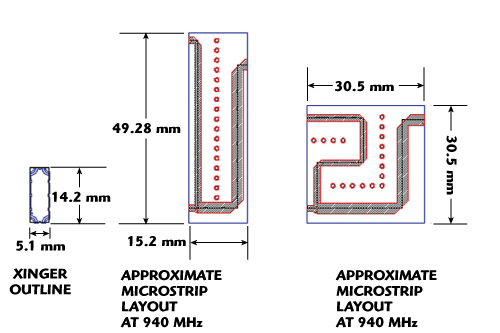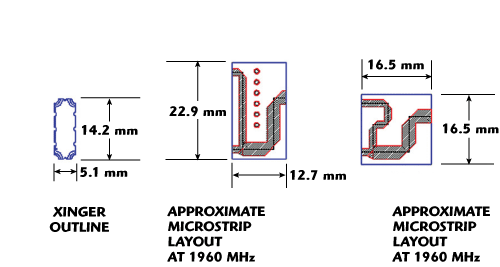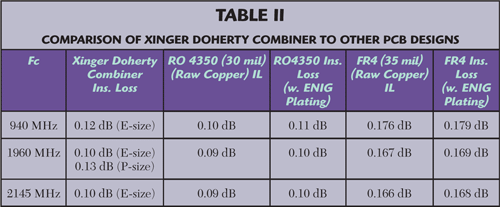
First introduced in the late 1930s by a Bell Telephone Laboratories electrical communications engineer named W.H. Doherty and deployed in numerous broadcast radio station transmitters for years thereafter, the Doherty amplifier has been widely adopted in recent years by wireless infrastructure manufacturers seeking to squeeze every dB, W and penny out of today’s base station equipment. The attractiveness of the Doherty design is largely due to its inherent efficiency in managing input signals with a high peak-to-average ratio (PAR), which are typical of today’s systems (e.g. W-CDMA, CDMA2000, and emerging systems structures like WiMAX and LTE).
A typical implementation of a Doherty amplifier is shown in Figure 1, wherein a “main” amplifier runs at all times and a “peak” amplifier switches on only when a certain power threshold is needed. When the main and peak amplifiers (both matched to 50 ohm) are turned on and delivering maximum output power, the combining circuit functions as a 1:1 combiner.

Figure 1 Typical Doherty amplifier configuration.
When peak amp is off and presents high output impedance, the main amp port sees 100 ohms and the combining circuit functions as a 2:1 impedance transformer. This unique combiner is called a Doherty combiner, and it is today typically printed on premium-quality printed circuit board (PCB) that is 20 or even 30 mils thick in order to minimize insertion loss.

Unfortunately, some of the performance and efficiency gains achieved in the overall Doherty amplifier execution are lost in the PCB-based combiner, unless a thicker, higher-end board is used and there is ample real estate available. One new approach to recapturing real estate or performance lost via PCB-based Doherty combiners is a new line of Xinger®-III brand Doherty combiners from Anaren (currently nine part numbers covering bands from 728 up to 2170 MHz; see Table 1).
Like all ‘Xingers,’ this new combiner is a standardized, softboard SMT component that offers a range of both physical and performance advantages for infrastructure OEMs seeking continuous improvement of transmitter performance and cost management.
SMT Combiners Save Space and Improve Manufacturing Reliability

Figure 2 Size comparison of Xinger and typical microstrip layouts at 940 MHz.
The most self-evident benefit of the Xinger Doherty combiner is its compact packaging. Currently available in a P-size footprint (6.35 × 5.08 mm) and an E-size footprint (14.2 × 5.1 mm), these new components are approximately 1/10th the size of their equivalent PCB-based printed combiner layouts. Figure 2 shows the E-size Xinger combiner relative to a best-case 940 MHz microstrip layout for a printed Doherty on 30 mil RO4350 (measuring 49.28 × 15.2 mm or 30.5 mm square), while Figure 3 shows the Xinger beside a best-case 1960 MHz printed Doherty on the same board (measuring 22.9 × 12.7 mm or a layout of 16.5 mm square).

Figure 3 Size comparison of Xinger and typical microstrip layouts at 1960 MHz.
For the design engineer, this reduction in size translates into added space for other functionalities, the potential use of smaller amplifiers, or cost savings associated with using a smaller PCB. The smaller, SMT-style Doherty combiner’s footprint can also mean an opportunity to adopt a well-known approach in amplifier designs, a balanced Doherty amplifier that would otherwise not be possible due to the size of PCB-printed Doherty combiners (see Figure 4). This configuration should help achieve better stability and gain flatness, as is typically seen with balanced amplifiers. In addition, as smaller transistors are used compared to a “single Doherty amplifier,” the transistor impedance is higher and making the device easier to match, improving bandwidth and manufacturing.

Figure 4 Balanced dual-Doherty amplifier.
Additionally, the Xinger Doherty combiner’s standardized footprints help OEMs migrate toward system-level standardization to account for global market distinctions. And, as is the case with most discrete SMT components, repeatability of performance from unit to unit is superior to printed PCB executions, which can vary significantly based on materials used, manufacturing conditions and expertise of the PCB printing processor.
Another advantageous physical characteristic is the Xinger’s softboard construction. Because these parts are manufactured using materials with coefficients of thermal expansion (CTE) compatible with common PCB substrates such as FR4, Rogers 4350, RF-35 and polyimide among others, they expand and contract at the same rate as the PCB they are mounted on, which improves reliability.
Lower Loss Improves Amplifier Efficiency
In addition to physical and dimensional advantages, Anaren’s Doherty combiner takes sizeable steps toward recapturing performance losses seen with printed Doherty’s. Chief among these are very low insertion loss.

Table 2 starts with a conservative comparison between the two approaches, which assumes the printed Doherty combiner is executed on a very high quality board material such as RO4350 in 30 mil thickness. In this head-to-head comparison, the much smaller Xinger combiners’ 0.10 to 0.13 dB losses are nearly on par with the 0.10 to 0.11 dB loss range typically achieved with a Doherty printed on high-end PCB. It then compares the Xinger combiners with Doherty combiners as they would perform when printed on a more common ‘cost conscious’ board, such as FR4 (with ENIG plating). Here, the Xinger part’s 0.10 to 0.13 dB loss range compares very favorably with the 0.168 to 0.179 dB losses typical of the printed solution. In today’s systems, this is a significant performance gain. Another performance advantage of the Xinger Doherty combiner is the repeatable low return loss, made possible by the component’s high performance materials and precision etching.
On the cost front, Anaren’s Xinger Doherty combiner will be in the range of $1.65 each for the E-size units (in higher quantities) and $1.49 each for the P-size in like quantities. Additional savings can be realized through the minimization of PCB size and by eliminating design time and other resources needed to maintain a standing and current library of PCB-based Doherty designs to account for various applications.
Even more significant may be the cost savings made possible in the selection of PCB material. As discussed previously, there are some instances when a premium board material becomes the only way to achieve low insertion loss given the inherent inefficiencies of a printed Doherty; in other instances, higher insertion losses are tolerated as a trade-off for using a lower cost board. With Anaren’s softboard Doherty combiner, the equipment manufacturer achieves the best of both worlds—excellent Doherty performance with a more competitively priced board.
Anaren,
Syracuse, NY
(315) 432-8909
www.anaren.com
